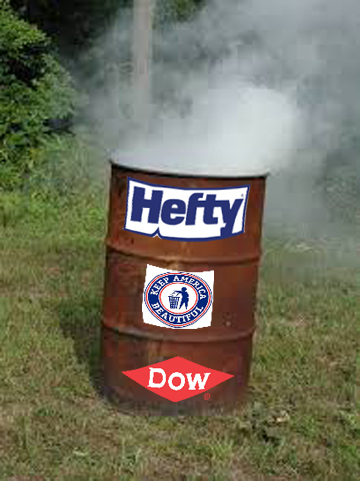Air Quality
Mysterious Catastrophic Air Pollution Episode is Why DFW Needs its Own Air Sensor Network
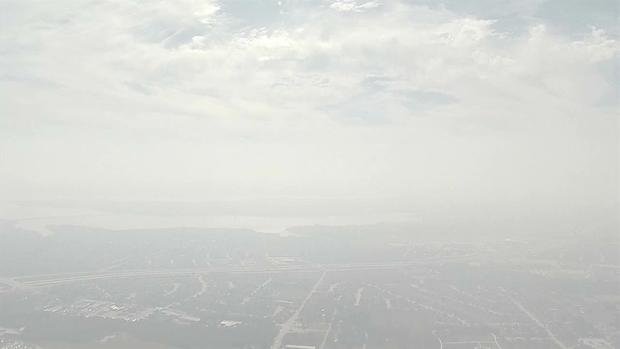
Not quite two weeks ago, on Thursday October 19th, something happened to throw local air quality conditions into the red zone for most of the day.
There was a inexplicable smokey haze extending along the limestone escarpment from Midlothian to Dallas and then north to Denton, sending Particulate Matter pollution soaring to Beijing levels and ozone readings so high the whole regional average went up a part per billion. Countless downwind residents complained to officials, FaceBooked, and Tweeted about “the smell of burning plastic” enveloping their neighborhoods with the smoke, which was so thick many thought the problem was just down the street.
 The 24-hour standard for Particulate Matter Pollution is 150 ug/m3. The annual standard is 12.
The 24-hour standard for Particulate Matter Pollution is 150 ug/m3. The annual standard is 12.

70 ppb is the new ozone standard.
The events took the Texas Commission on Environmental Quality completely by surprise. Commission computer forecasting had not predicted an Ozone Alert Day or warned of heavy PM pollution. Officials were playing catch-up for the rest of the day.
Now almost two weeks later nobody official knows what caused this Really Bad Air Day. Not the EPA. Not the Texas Commission on Environmental Quality. Not the DFW area citizens who breathed in the dirtiest air their lungs have seen all year.
Despite the sophisticated technology available to us in 2017, a single unexpected incident upwind of DFW can throw the entire North Texas air shed into the danger zone with no warning and no clue as to what initiated it.
Readings from state monitors were of no help until damage had already been done. As usual they were two hours or more behind in reporting. The numbers they were displaying at 12 noon were actually taken at 10 am. You had no idea what was going on in real time so that you might better protect yourself or family.
There are only three or four Particulate Matter pollution monitors in all of DFW. Even if you’d wanted to use the state’s current monitoring system to track this mystery plume, you couldn’t have done so. It doesn’t have that capability.
As inquiring reporters called, the TCEQ staff found a variety of things to blame. TCEQ suggested the smoke was from a Bastrop forest fire near Austin. But readings from monitors between Bastrop/Austin and Dallas show there was no problem south of Midlothian that day, while there was a huge problem north of there at the same time. Eyewitnesses who saw the plume on Thursday reported a thick narrow ribbon of a plume you’d see coming off a near-by source, not the sort of diffused cloud you’d expect to witness after traveling more than a hundred miles downwind. And then there’s that “burned-plastic smell.”
Then it was maybe one or more “controlled burns” in the Midlothian-Mansfield area. As it turns out, neither fire department found evidence of any permitted controlled burns in their own jurisdictions that could have cause so much pollution. Midlothian’s single permitted fire for the day was “the size of a coffee table” according to a department employee.
According to the Mansfield Fire Department “a fire” was reported to be located at Kimball Road and Hwy 287 just north of the Midlothian city limits. This is what’s at that intersection:

Please note the caution against open flames. Could a fracking site have produced the kind of particulate matter pollution and haze we saw on October 19th without methane or other kinds of pollution being released en masse as well? It doesn’t seem like it could. But what if the fracking site had been turned into a temporary waste incineration site for the day?
That’s not all. A satellite pic of the intersection and what’s around it reveals Kimball and Hwy 287 to be a kind of rogue’s gallery of potential suspects:
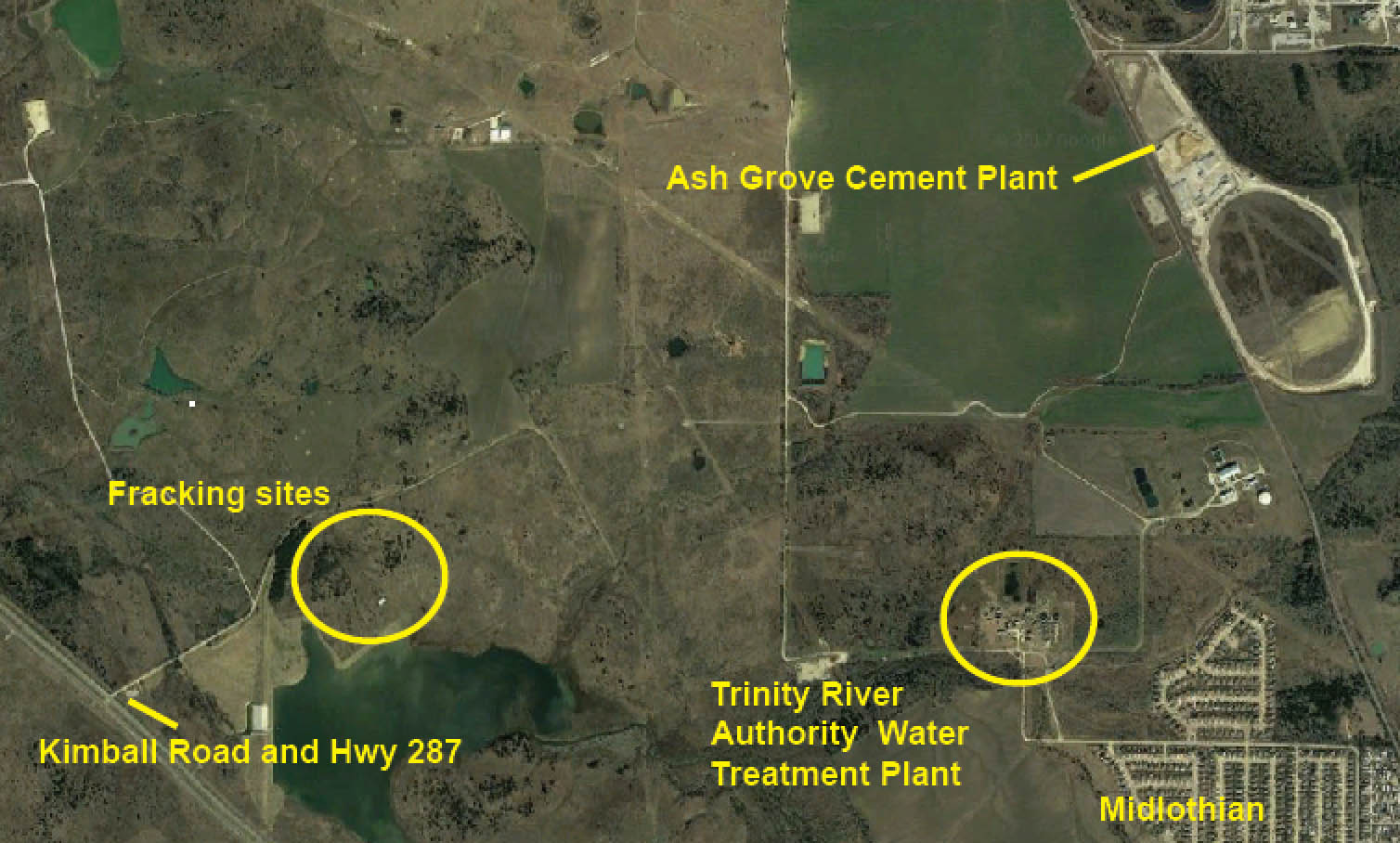
Besides the fracking sites you can be see in mid-drilling on this Google street level tour, the road leads to a Trinity River Authority Wastewater Treatment plant and the back door of the giant Ash Grove cement plant.
TRA is a shadowy, 60-year old regional bureaucracy that owns millions of acres of land, reservoirs, landfills, and wastewater-treatment facilities. It’s been in environmental hot water before. Wastewater treatment accumulates a lot of solids, and the TRA handles a lot of trash. It’s not inconceivable that it had something to do with the October 19th incident by thinking it could get away with an open burn on its own property.
Ditto for Ash Grove. Like the other two cement plants in Midlothian, Ash Grove’s kiln is allowed to burn industrial waste, including used oil, tires and plastics – remember the oft-cited “smell of burning plastic” citizens reported on the 19th? Waste-burning cement plants have had their wastes combust and cause huge fires before and each plant has its own emergency response crew which might be able to put out a fire without calling Midlothian.
There’s no proof Ash Grove, TRA or the fracking sites were the cause of the October 19th public health disaster. But there’s also no proof yet they didn’t cause the problem.
The truth is: there’s no official explanation for what made the air so dangerous to breathe on October 19th .
More truth: As of Friday, October 27th the TECQ had not even opened an official investigation into this matter – which again, sent Particulate Matter pollution to levels not seen outside SE Asia and single-handedly raised the regional ozone level.
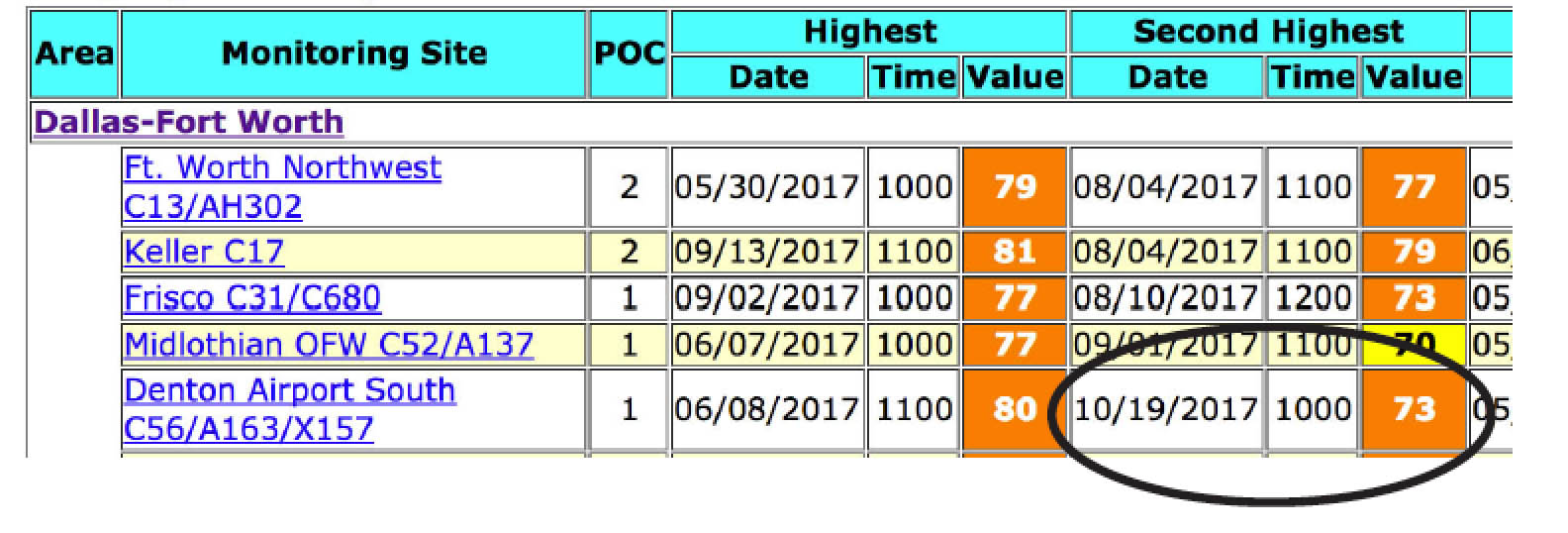
This is why Downwinders at Risk filed the first of what we’re sure will be a series of Texas Open Record Act requests last Friday seeking:
“Any and all printed or electronic documents and electronic media containing information concerning or related to ozone, particulate matter and/or haze air pollution readings and levels in the Dallas-Forth Worth non-attainment area on Thursday, October 19th 2017, including official ozone action warnings issued, complaints filed about air quality in the Dallas-Fort Worth area that day, photographs, satellite images, computer modeling, as well as all material related to any questions, inquiries, or investigations about air quality in DFW on October 19th anyone in the TCEQ, or contracted by TCEQ has been tasked to perform since October 19th or is still performing currently, and e-mails, letters, reports, telephone logs and notes, memos and all other material about October 19th air quality from 6 am Tuesday October 19th to Wednesday October 25th, 2017.”
TCEQ has until November 10th to respond. We’ll keep you posted.
In the meantime, this episode becomes Exhibit A in why DFW needs to catch-up with other metro areas and build its own network of high tech air quality sensors.
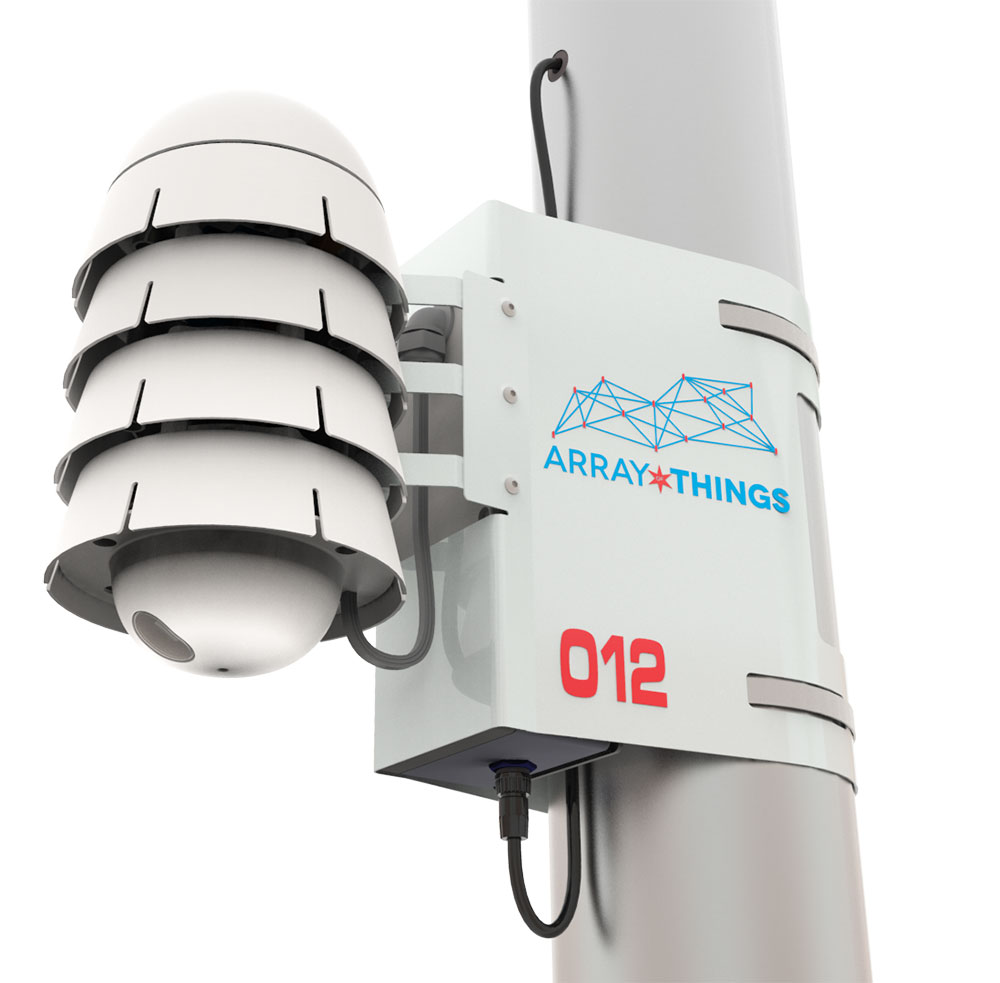
If such a grid had been in place, there would have been a real time warning of the PM and ozone pollution being generated shortly after the it started. There would have been a way to locate the source of the pollution right away and do something about it before it got worse, and there would have been a way to predict the plume’s course and warn those in its path before it got there – not two hours after it arrived.
In this sense a modern sensor grid is actually a pollution prevention device, an investigative tool, and an early warning system all rolled into one.
In a metropolitan area that’s been out of compliance with the Clean air Act for 27 years and counting over 14 million lungs are being held hostage by a state air quality monitoring system left over from the 1990’s. It’s being maintained by a state agency that’s run by polluters, officially thinks smog isn’t bad for you, and is cutting its air monitoring budget.
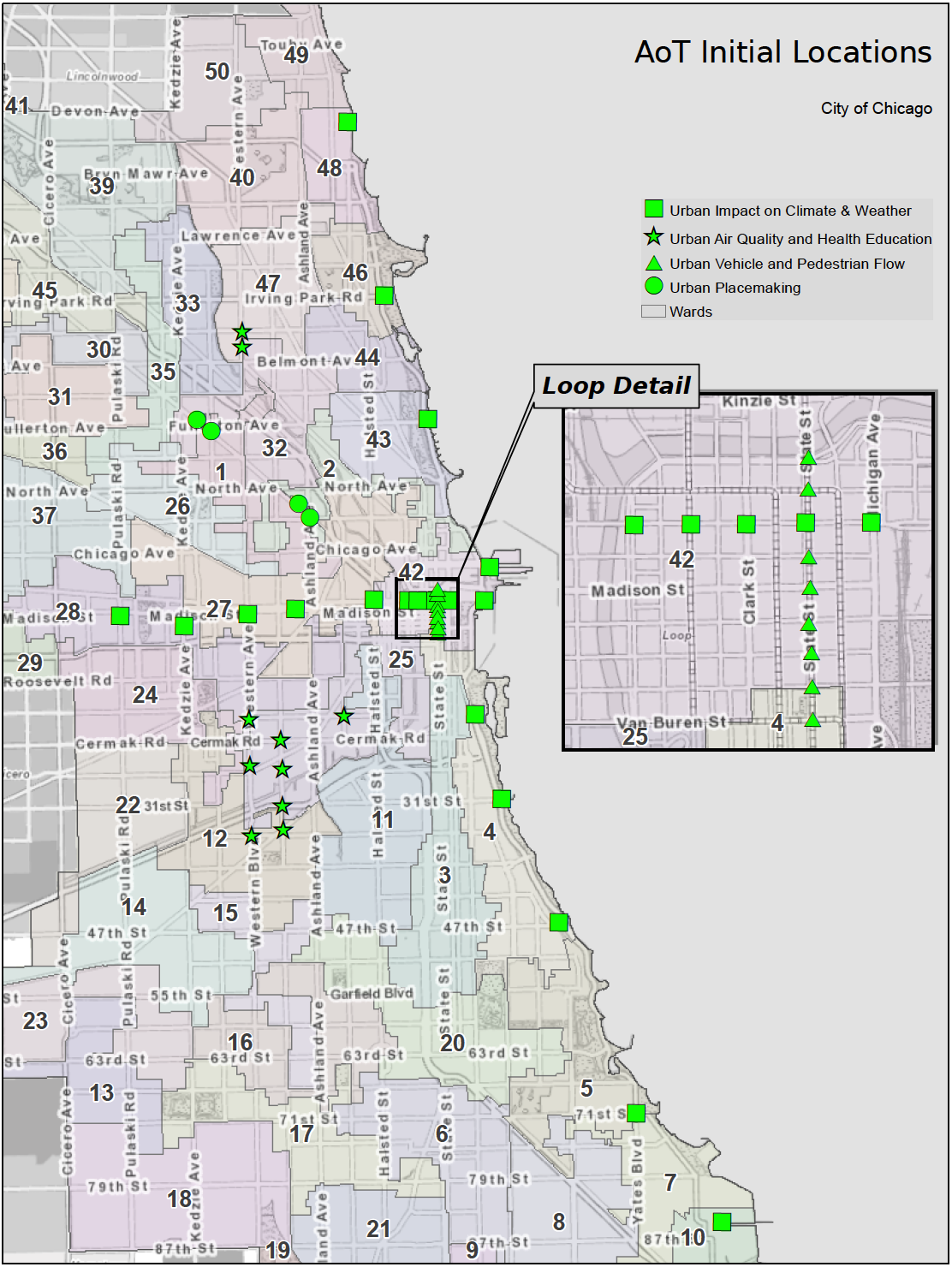 There’s no desire in Austin to update this obsolete system and no money to do so. If DFW officials want to utilize 21st Century technology to help them clean their air, they’re going to have to build their own network of air monitors – exactly the proposal the DFW Air Research Consortium was trying to get funded with a National Science Foundation grant. Close, but no cigar.
There’s no desire in Austin to update this obsolete system and no money to do so. If DFW officials want to utilize 21st Century technology to help them clean their air, they’re going to have to build their own network of air monitors – exactly the proposal the DFW Air Research Consortium was trying to get funded with a National Science Foundation grant. Close, but no cigar.
Without the NSF grant, local officials are going to need to get creative. Are there private businesses who might want to sponsor an app that could tell give you useful air quality info in exchange for naming rights: “Brought to you by the Nissan Leaf DFW Clean Air Network.” Are there local foundations that would contribute? What about local high-tech billionaire Mark Cuban? For less than a million bucks, DFW could have 500 Particulate Matter sensors that would be capable of of pinpointing a problem down to the street address.
Baltimore, Chicago, Chattanooga, Louisville, L.A. , Oakland, and Lafayette, Louisiana are all way ahead of DFW in building out their own local dense grid of air sensors. They’ve done it with a combination of private, government and academic know-how and financing.
We have as much, or more technical expertise and money than any of those locales and we should have more incentive given our chronic air pollution problem. There’s no reason we can’t build our own modern, more protective, more useful way of monitoring air pollution – even if the state isn’t interested. Not only can we do it, but in light of the events of October 19th, it should be considered a necessary act of public health self-defense.
Brown, Big: 1971-2018
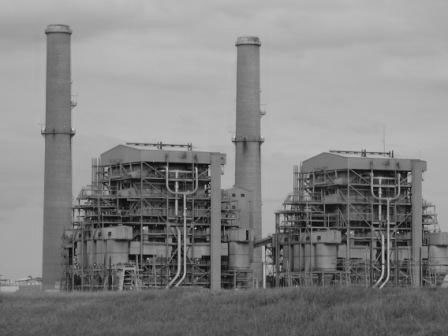 After years of declining fiscal health, the Big Brown lignite coal plant finally succumbed last Friday. An announcement was made by its most recent caretaker, Vistra Energy last Friday morning. The cause of death was obsolescence. It was 47.
After years of declining fiscal health, the Big Brown lignite coal plant finally succumbed last Friday. An announcement was made by its most recent caretaker, Vistra Energy last Friday morning. The cause of death was obsolescence. It was 47.
Controversial from its birth, the 1. 2 Gigawatt Big Brown lived up to its name and was Texas Utilities’ flagship power plant for decades. It began by burning 100% Lignite Coal, the mud-like fossil fuel native to East and Central Texas. By the end however, it was importing thousands of tons of “cleaner” Wyoming Powder Basin Coal in long freight trains to comply with interstate pollution rules.
Along with other coal-fired power plants in East Texas, Big Brown was citied for causing acid rain to by SMU Chemist George Crawford as early as the 1980’s. It was then discovered to be a major contributor t0 Dallas-Fort Worth smog, a fact reinforced by a 2008 study from another SMU professor and former EPA Regional Administrator Dr. Al Armendriz, and more recently by Dallas Medical Society’s Dr. Robert Haley in his 2015 report on ozone levels and public health in DFW. Public Citizen/Texas and the Sierra Club had been particularly hostile to the plant’s continued operation.
As coal lost favor as an energy source, Big Brown’s estimated lifespan had been the subject of countless rumors over the last decade. Towards the end the plant consistently refused modern technology which might have prolonged its life, such as Sulfur Dioxide scrubbers and Selective Catalytic Reduction for smog pollution.
The timing of the plant’s demise was seen as a major embarrassment to officials in the Trump Administration, who’ve promised to promote coal. On the same day as Vistra’s notice about Big Brown’s demise, Trump appointed known fossil fuel promoter Kathleen Hartnett White to lead the White House Council on Environmental Quality.
It was the third Texas coal plant to expire in less than a week. Big Brown was preceded in passing by the Monticello lignite plant, which announced its departure on October 6th. Vistra said its smaller Sandlow power plant near Bastrop was to be closed in 2018 as well.
In 2016, these three coal plants emitted a total of 166 million pounds of sulfur dioxide, 24 million pounds of nitrogen oxide, and 21 million tons of carbon dioxide pollution. Their absence during the 2018 “ozone season” could be the first time DFW stands a chance of complying with the Clean Air Act in 27 years.
Survivors, for now, include the coal-fired Martin Lake and Oak Grove power plants, as well as NRG’s Limestone power plant, southeast of DFW.
Announcing Downwinders 3.0

Downwinders is Regrouping, Renewing, and Regenerating. Almost half our new board is under 30. We have a new scientist. We have a new focus. Now we need you.
Many of you are aware of the time and effort Downwinders at Risk put into the unprecedented UNT Ozone Study which brought DFW elected officials and local atmospheric researchers together for the first time to operate the same computer model for air quality used exclusively by the State and EPA.
The results of that study provided a practical map for compliance with the current federal ozone standard: new controls on coal plants, cement kilns and gas facilities. It was shared by local officials with the EPA in hopes of that agency drafting a new DFW air plan that might finally address these major sources of local air pollution.
Those hopes were dashed by the presidential election last fall.
Because of a perfect storm of regulatory changes and politics, we now believe that the EPA won’t intervene on behalf of DFW air quality for the foreseeable future. It appears DFW will not even have to submit another serious plan to address smog for at least a decade – if then.
Over the last 20 years no other group has leveraged as much change from DFW federal clean air plans as Downwinders at Risk. We won the first comprehensive study of cement plant air pollution control technology by the state. We got new smog-control technology installed on the Midlothian cement plants. We used the “Green Cement” provision of another federal smog plan to stop the burning of hazardous waste in those cement plants and close the oldest, dirtest kilns in North Texas. In the most recent plan, we exposed the large impact of oil and gas pollution on local DFW smog levels.
But while we’ll continue to stay in the EPA’s ozone/smog regulatory loop through legal representation, we don’t see any opportunity to impact public policy using federal clean air plans the way we have in the past.
With this change, we had to rethink how we work toward better regional air quality in North Texas. How do we impact the most lives, in the biggest ways, with the resources we have?
We’ve come up with three strategies, all of them taking advantage of our long history of increasing the ability of local residents and governments to take on dirty air themselves.
____________________________________________
OUR NEW PRIORITIES
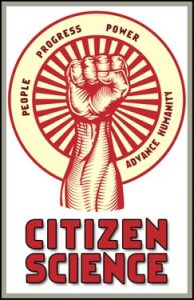
Build a modern, independent, and citizen-friendly regional air pollution monitoring network for DFW
You can’t fix problems unless you know about them, and this is a way to begin building a regional alternative to state monopoly of air quality expertise and resources.
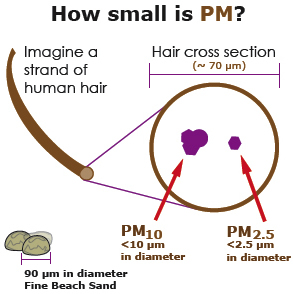
Identify, reduce, and eliminate health threats posed by widespread Particulate Matter (PM)pollution in DFW
PM is the new smog and local campaigns to reduce it can help a lot of people, especially those predominantly minority neighborhoods who’ve been dumped on the most.
Organize a grassroots campaign to restore local government zoning control of industrial hazards
A state government bought by polluters has gone too far in restricting the liberties of Texans and demolishing democracy at the local level. We’re fighting back.
____________________________________________
We co-founded the DFW Air Research Consortium last year with researchers from area universities and local governments with the idea of building a modern and locally-controlled air quality monitoring grid across DFW that can track pollution plumes in real time. This can become a powerful grassroots enforcement and education tool.
Downwinders itself bought two EPA-certified ozone monitors we’ll be using to specifically track smog levels in Wise County, where the State refuses to put a monitor despite evidence that’s where the region’s highest ozone readings are located.
This is more than just increasing the number of monitors – this is an opportunity to change the way people see air pollution affecting their lives. It’s also another opportunity to take what was the exclusive regulatory providence of an apathetic state government and give it to more concerned local governments.
We’re also beginning a new campaign focusing on microscopic pieces of soot known as Particulate Matter, or PM pollution. In recent years, PM pollution has been linked in the scientific literature to a wide variety of non-respiratory and cardiovascular diseases including ADHD, autism, Parkinson’s, dementia, and infertility. Like lead, many researchers believe there is no safe level of exposure to this kind of pollution.
Sources of PM pollution include any internal combustion engine, furnace, boiler and windswept piles of sand, or cement dust. Studies have found a correlation between proximity to a major source of PM pollution and increased risks of illness.
This is why other communities around the country are cracking down on idling trucks and buses and establishing buffer zones between major freeways and residences, parks and schools. We want to reduce the pollution as well as the exposure to it.
Finally, because there’s no hope of addressing air pollution from the oil and gas industry without any change in HB 40, the 2015 state law that took away local control of industrial zoning, we’ve begun a project aimed at building an alliance that challenges state overreach and promotes the restoration of traditional local control. Cities must have the right to protect their residents’ public safety and health. This campaign will challenge the status quo in both Austin and North Texas.
As always, they’ll also be campaigns we could not anticipate but have to wage. One example is the recent proposal by Dow Chemical to bag municipal trash for burning in the nation’s cement kilns. Dow has already targeted the local cement kilns in North Texas for this scheme, but Downwinders is pushing back hard and working with nationwide alliances to halt this project before it gets very far.
NOW WE NEED YOU

This coming THURSDAY is another North Texas Giving Day, a chance for your donations to be magnified by challenge grants and other incentives over the day. Because we’ve added responsibilities and staff, Downwinders at Risk needs this one to be our best, most productive Giving Day yet.
All transactions take place online that day. It’s simple to give and you can link to the Giving Day pay portal through our Downwinders’ website or FaceBook page beginning at 6 am on the 14th, and going all the way to midnight:
https://northtexasgivingday.org/npo/downwinders-at-risk-education-fund
DFW has been in continuous violation of the Clean Air Act for 26 years. We’re asking you to take a minute and contribute $26 to clean air work in the place where your lungs do most of their breathing.
We know hurricane season is testing the limits of our charitable giving, but $26 is all we’re asking. At a time when the state and federal government are intent on not protecting our air, Downwinders continues to be stubborn advocates for progress.
We deeply regret not being able to win a clean air plan for DFW in 2017 that might finally leave us in compliance with the Clean Air Act. But our long term goals remain the same. We hope you agree our work is worth your continued support. Thank you for your consideration.
STUDY: Even Very Low Levels of Air Pollution Increase Mental Illness in Children
 Most of us are used to hearing about the traditional physical ailments caused by breathing poisoned air, and even about the more recently-connected neurological impacts. But a new Swedish study is the first time we’ve seen a report linking air pollution to mental illness in children.
Most of us are used to hearing about the traditional physical ailments caused by breathing poisoned air, and even about the more recently-connected neurological impacts. But a new Swedish study is the first time we’ve seen a report linking air pollution to mental illness in children.
The new research, peer reviewed and published by the journal BMJ Open, found that relatively small increases in air pollution were associated with a significant increase in treated psychiatric problems. Its conclusions are consistent with a growing body of evidence that air pollution can affect mental and cognitive health.
Two things about this study stand out: 1) How rigorous it was. It examined the exposure levels of over 500,000 Swedish kids under 18 for more than three years; 2) The very low levels of air pollution linked to increased diagnosis and treatment. This is a familiar story, but it’s driven home by a new correlation to mental illness. The more we examine the impacts of toxins on people, the more we understand there is no “safe level” of exposure we can count on. The variety of nuanced adverse health effects will not be as obvious as cancer or asthma. Instead they might show up as depression, or the inability to conceive.
The pollutants studied were Particulate Matter and Nitrogen Dioxide. There’s already a large body of evidence linking PM pollution to neurological diseases and learning disabilities. Tiny PM uses the body’s bloodstream as a highway to hitchhike its way to any organ. Since so much of our blood goes to our brain, it’s not surprising that so many brain functions are affected by it.
“The results can mean that a lower concentration of air pollution, first and foremost from traffic, may reduce psychiatric disorders in children and adolescents,” said Anna Oudin, at Umeå University, who led the study. “I would be worried myself if I lived in an area with high air pollution.”
But has her own study shows, you don’t have to live in areas with “high air pollution” to be impacted.
Cowtown Redux for “21st Century Air Monitoring” Sept 7th
 If you missed our “Science and Socializing” series of roll-out events for the DFW Air Research Consortium in June, you have a chance to catch the show again on Thursday September 7th when the Fort Worth League of Neighborhoods is using its September monthly meeting to host a repeat performance.
If you missed our “Science and Socializing” series of roll-out events for the DFW Air Research Consortium in June, you have a chance to catch the show again on Thursday September 7th when the Fort Worth League of Neighborhoods is using its September monthly meeting to host a repeat performance.
Dr. David Sterling and Graduate Assistant Leslie Allsop of UNT Health Science Center, as well as Downwinders at Risk Director Jim Schermbeck are the featured speakers.
In just a little over a year, the Air Research Consortium has grown in both size and ambition since being co-founded by Downwinders and local university professors to push the goal of a dense grid of sensors for DFW providing more detailed real time information on air quality than the status quo. At last count, the cities of Dallas, Fort Worth, and Plano had joined, along with UTD, TCU, UNT, UNTHSC, UTA, Liveable Arlington, and Mansfield Gas Awareness.
Although the group’s proposal to the National Science Foundation for funding a grid pilot project next year didn’t get selected over the summer, it did make it to the final round and give the members confidence in the idea. New sources of support for the grid are being explored, and more cities are adopting this more comprehensive approach to monitoring.
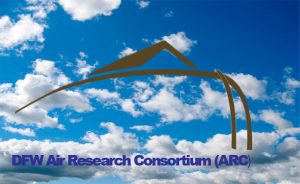
Meanwhile, two other Consortium projects are moving forward.
One is matching ten Particulate Matter and Ozone sensors with as many local public schools in Fort Worth, Dallas. Richardson and Plano. The other is Downwinders’ own Wise County Ozone Project, which commits two ozone monitors to a place no state ozone monitor has ever been.
Building the Consortium’s air monitoring grid has become a major goal of Downwinders because of its potential to give citizens a powerful new tool. Our on-going job is to figure out how best to integrate this new sensor technology into our traditional community organizing model to get change faster on the ground. We truly believe this new kind of air monitoring can change the way people “see” air pollution and how it impacts their lives.
But don’t take our word for it. Come see the presentation on the 7th and decide for yourself.
Meet Our New Scientist
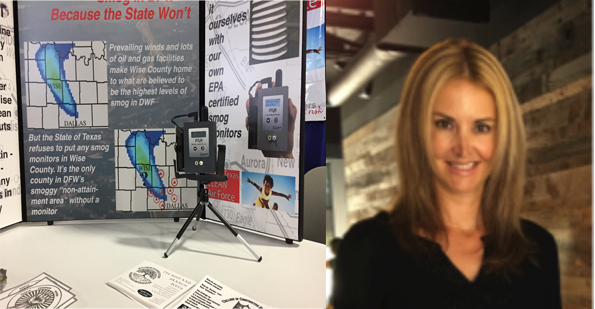 Downwinders’ Wise County Ozone Project Gets A Director
Downwinders’ Wise County Ozone Project Gets A Director
Downwinders at Risk is proud to announce Kari Northeim, a doctoral student in Environmental Sciences at the University of North Texas, has agreed to become our Wise County Ozone Project Director.
Kari brings an impressive resume and a rigorous level of scientific methodology to the use of our two new EPA-calibrated portable ozone monitors we purchased earlier this year.
She has an undergraduate degree in Engineering from Iowa State, has two more years at San Francisco State studying Meteorology, including climate change modeling and global warming research. Still not satisfied, she went and got a Business degree at Syracuse, worked in the private sector for 16 years, went back to teach High School science, and is now pursuing a PhD. in Environmental Science – Biological Sciences with an emphasis on Health Geographical Information Systems. Did we mention Kari has an impressive resume?
But it’s more than accumulated degrees. Kari’s father and all of her siblings are engineers, while her mom is a math teacher. Number crunching is in her blood. And she wants to use those mad skills to help the environment and people. So instead of making small fortunes for Wall Street firms or multinationals, she’s helping non-profits do original research in smog pollution.
How did we find her? She found us. Following her UNT adviser’s advice to catch the presentations on 21st Century air quality monitoring featured in Downwinders’ series of Evenings of Science and Socializing last June, she drove down to Fort Worth, saw the show, and stayed to talk. It’s a great outreach event when it snags this kind of talent (and courtesy of the Ft. Worth League of Neighborhoods, you have a chance to see a repeat of that Cowtown performance September 7th – see the notice below).
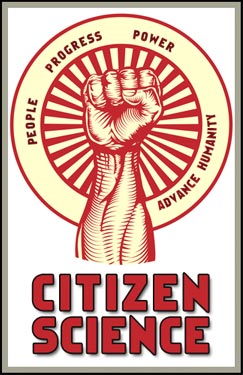 Believed to be the largest, or at least most ambitious citizen-science project in North Texas, Downwinders’ Wise County Ozone Project is going where no state or federal monitoring for smog has gone before: into the only DFW “non-attainment” county without an ozone monitor.
Believed to be the largest, or at least most ambitious citizen-science project in North Texas, Downwinders’ Wise County Ozone Project is going where no state or federal monitoring for smog has gone before: into the only DFW “non-attainment” county without an ozone monitor.
Wise County is where fracking was born and the gas industry still dominates many parts of it. It’s also where a lot of everyone else’s smog accumulates. Predominant southeast winds push it from the Gulf Coast all the way to Midlothian, through the metro DFW area, and into Wise County.
Based on past computer modeling by the State itself, ozone levels are often predicted to be higher in Wise County than any other 10 DFW non-attainment counties – but there’s still no State monitors there.
That gap in local public health information is intentional and it’s that gap the Wise County Ozone Project is filling.
Northeim is already drafting plans on how best to put the monitors to the test in the field. She wants us to have the ability to use them as stationary monitoring sites, as well as be able to take them with us on the road. It’s a complex and long-term mission that Northheim says she relishes. And she’ll be putting out the “Help Wanted” sign soon as she recruits other citizen scientists and volunteers to help, so stay tuned. You too can become a citizen scientist for the public interest.
Finding Kari was a real coup. But from its founding, Downwinders has had a long and distinguished history of working with great scientists and using sound science to advance the cause of cleaner air.
Dr. Marvin Legator’s 1996 report on the State’s toxicity classification system eventually led to some changes in Austin. Dr. Stuart Batterman did a landmark public health critique of the TXI hazardous waste burning permit in the late 1990’s. Dr. Al Armendarez, an engineering professor at SMU when he started out as Downwinder’s technical adviser, left in 2009 to become the first engineer ever to be appointed as Regional Administrator for EPA. In 2015, Dr. Kuruvilla John of UNT’s Physics Department used that school’s supercomputers to reproduce the state’s air modeling for DFW outside of Austin for the first time so elected officials could see what impact new pollution controls would have.
Soon-to-be Dr. Kari Northeim is the latest effort by Downwinders to develop local DFW expertise to help solve DFW air pollution problems. Please join us in welcoming her to the cause and consider signing-on to what is sure to be another historic challenge to the Status Quo.
HEFTY! HEFTY! HEFTY! is TOXIC! TOXIC! TOXIC!
Anti-Litter Group “Keep America Beautiful” Teams-Up with Dow and Hefty to Burn Plastic Bags Full of Plastic Garbage in Cement Kilns
And They Want To Do It Here…
We’ve been warning you for a while that garbage burning was coming to North Texas one way or another.
What we didn’t anticipate was that “Keep America Beautiful” would bring it.
That’s right. The same group that gave you Oscar “Iron Eyes” Cody crying over litter is now prepared to make your own eyes water and sting from the air pollution it wants to encourage by burning municipal solid waste, especially “hard-to-recycle” plastics.
Touting bright orange “energy bags” as a quick and easy alternative to throwing those plastics away, a news release issued by the Keep America Beautiful folks, your friends at Dow Chemical, and Reynolds, the makers of “Hefty” trash bags, claims they’re “a convenient way to collect plastic materials that would otherwise end up in the landfill and offers a platform to promote positive behaviors to prevent this material from being wasted.”
What they don’t tout as much is their alternative to throwing these plastics into a landfill – throwing them into a furnace.
As long as cement kilns need a high-temperature flame to make their product, they have large energy costs. Typically, 30% or more of the costs of running a cement plant is in buying the flammable materials necessary to keep that flame lit.
 History has taught us that cement kiln operators will burn anything, including the kitchen sink, if they think it will help reduce those high fuel costs.
History has taught us that cement kiln operators will burn anything, including the kitchen sink, if they think it will help reduce those high fuel costs.
Kiln flames in Texas used to be powered by natural gas exclusively. Then it was coal. Then it was hazardous waste and coal. Then industrial wastes. And now municipal solid wastes. In bright orange plastic bags.
Cement plants don’t have to pay for the wastes, now termed “fuel,” for regulatory loophole purposes. In fact, because it’s now a “fuel,” they often get the waste for free or even get paid to burn it. It becomes a new center of profit in the company besides making cement. Maybe even more important. In the 1990’s, there were plenty of rumors about how the TXI cement plant in Midlothian would burn a lot of hazardous waste they got paid a handsome fee to take, but not have much cement product to show for it.
While garbage burning cement kilns have been on the rise in the developing world, the practice hasn’t caught on in the U.S.
Dow’s and Keep America Beautiful’s friendly neighborhood “Energy bags” are a way to jump start it.
This is already happening in Omaha, where 8,500 homes have filled 13,000 “Hefty Energy Bags” since the program’s launch in October. That’s resulted in more than 13,000 pounds of plastics being burned in a near-by Ash Grove cement kiln. They’re so excited about burning plastics at Keep America Beautiful that they’re not only endorsing the practice, they want to bring it to a cement kiln near you.
At a news conference to announce the offering of cash money grants to local communities who wanted to try the option, they unveiled a contiguous states map of the US where they’d like to see the “energy bag” concept implemented. The approximately 50 locations on the map identified by a red (not orange?) star are almost all sites adjacent to large cement plants – including Midlothian, immediately south of the Dallas and Tarrant Counties line, and home of the largest concentration of cement manufacturing in the nation.

Local candidates for eager participation in the project include TXI, the cement plant that burned hazardous waste by the thousands of tons from 1987 to 2008, Holcim, which has sought permits to burn carpet scraps and shingles, and Ash Grove, the same operator as the one burning Omaha’s plastic bags now.
BURNING PLASTIC IS BAD FOR PUBLIC HEALTH AND PUBLIC POLICY
1. It replaces real recycling with burning.
Once you have a hungry garbage burner, you have to keep feeding it with more and more garbage, decreasing the market for real recycling.
This is already happening with tires. There are good tire recycling programs that can’t stay afloat because local governments have promised the local cement kilns a certain volume every year.
2. It gives an incentive to the plastics industry keep to just making plastics that you can’t recycle.
Burning plastic garbage is like a relief valve on the growing piles of “hard to recycle” plastics that industry is producing. Just throw it in a bag and send it to the kiln. Out of sight, out of mind. There’s no question it reduces the percentage of plastics going to landfill…only to increase the percentage of plastic going into your lungs.
The real answer is to reduce and quit producing those “hard-to-recycle” plastics, not giving them a cheap way to get out of doing so.
3. Burning plastic produces lots of toxic air pollution – and all of DFW is downwind of Midlothian
Burning plastics produces toxic air pollution, a percentage of which escapes the smokestack and ends up in the air you breathe, the soil in your garden, and the food you eat and drink. Specifically, burning plastic creates lots of Dioxins and Furans – the same ingredients that made Agent Orange so toxic. The same poisons that made the State of Missouri evacuate the town of Times Beach in 1983.
Burning plastic also releases metals into the air, like cadmium and lead.
Other chemicals released while burning plastics include benzo(a)pyrene (BAP) and polyaromatic hydrocarbons (PAHs), which have both been shown to cause cancer. If plastic film or containers are contaminated with pesticides or other harmful substances, those will also be released into the air. If plastics are burned with other materials, whole new toxic chemicals may be created from the interaction of the different substances.
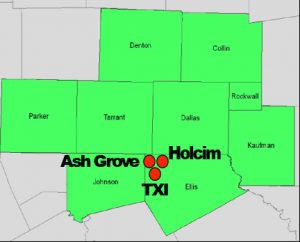
But wait! Don’t you want to divert more garbage from going to landfills?
Yes you do, but by eliminating, reducing and recycling the garbage – not taking a match to it.
Landfills are nasty things. They’re big and smelly and they leak. Sometimes they leak and contaminate ground and surface water. But these days you usually can trace the plume of those leaks and contain them before they get in drinking water.
On the other hand, once a piece of dioxin-contaminated soot is shot through a smokestack into the atmosphere, you have no idea where it’s going. You’re turning the whole sky into a landfill, full of solid and gaseous residues of refuse. What you didn’t want to drink, you’re now breathing. That’s the opposite of progress.
Taking a look at the Board of Directors for Keep America Beautiful, it’s no wonder they have a soft spot in their heart for large plastics manufacturers. They have not one, but two members from DOW, who, we are sure, thought this was a splendid idea.
Howard Ungerleider is Vice Chairman and Chief Financial Officer of Dow, and Greg Jozwiak is the Business President for the Elastomers and Electrical and Telecommunications businesses for the company. Prior to assuming his current role, he served as North America Commercial Vice President for the Packaging & Specialty Plastics business. Hmmmm.
But wait, there’s more! KAB has a board guaranteed to offend just about everyone. Not content with two Dow executives, it also has two Nestle Corporation members, a representative of Waste Management Inc., McDonalds, Keurig, Anheuser-Busch, and Phillip Morris – yes, that Phillip Morris.
“PEOPLE START POLLUTION. PEOPLE CAN STOP IT.”
Those are the words, spoken in a deep baritone by William “Cannon” Conrad, that ended that famous 1971 Keep America Beautiful commercial in honor of Earth Day. They ring as true now as then.
And so, people, we’re asking you to take action to discourage this kind of BAD IDEA from ever coming-up at a Keep America Beautiful board meeting again – send an email to their new Chair, Helen Lowman.
Ms. Lowman is a former FEMA and Peace Corps executive in the Obama Administration. She’s from Texas, worked at TCEQ, and graduated from Austin College…. So maybe messages from her fellow Texans will have more of an impact.

TAKE ACTION:
TELL KEEP AMERICA BEAUTIFUL’s NEW CHAIR YOU DON’T WANT TO BREATHE TOXIC AIR POLLUTION FORM BURNING PLASTICS
SEND AN EMAIL WITH JUST TWO CLICKS
And if you want to leave a public message for the group too, here’s the group’s FaceBook site.
Other citizens groups, including some national alliances and networks are gearing up to take on this latest proof that all wastes, no matter how toxic, roll downhill to cement kilns eventually.
Meanwhile, Downwinders is taking the lead and beginning the push back we hope buries this project in the bright orange trash heap of history. Join us in not just saying “No,” but “Hell No.” Send that email now and then find two other people that will do the same. Thanks.
And Now a Word From NOT our Sponsor

A note of explanation: There are two meetings next week in DFW concerning the large and complicated Volkswagen legal settlement over the company’s lying about the air pollution its diesel vehicles emit. Each state, as well as about 20 counties in Texas, are looking to score millions for various reasons and programs.
The two DFW meetings are sponsored by Public Citizen/Texas. We love Public Citizen and when they asked us to co-sponsor these meetings, we reflexively signed-up, even without knowing the details. There are efforts around the country to use this money to electrify school and city bus systems and challenge the status quo in interesting unconventional ways that might not be possible without large wads of cash.
But…what we didn’t know at the time we agreed to be co-sponsors was that the meeting is really a larger effort by something called the Texas Clean Air Working Group – an official statewide organization of local county governments working with other officials and businesses – to solicit comments…and most likely, direct the money to their priorities.
As a result, the North Texas Council of Governments is the major local coordinating entity for the Working Group. The COG will be presenting its version of a “DFW air quality update” and helping to coordinate responses. We did not know this until last Thursday, when we asked for details of who was doing what presentations.
This is problematic for Downwinders at Risk on a couple of fronts.
For one thing, NTCOG is one of the reasons DFW is STILL in violation of the Clean Air Act after 26 years. They have a perpetually overly optimistic perspective. They have a close relationship with TCEQ because they get so many grants from them, and they frequently side with the State on air quality issues. They see air pollution only thru the prism of federal transportation dollars at risk over our “non-attainment: status – not public health. In 2015 citizens had to raise money to do the DFW air computer modeling that neither TCEQ nor COG would do. You aren’t going to get a very realistic picture of DFW air quality, or the need to do more about it, from a COG presentation.
Secondly, the preferred use of the VW settlement money by many of these local governments and NTCOG is either expansion or replacement of their own natural gas fleets, or supplementing existing state programs the state legislature has refused to adequately fund, like the Texas Emissions Reduction Program (TERP). In effect the goal of most of the members of the Working Group is to reinforce the status quo, not change it.
Because of these reasons, we’ve asked to be taken off the list of co-sponsors. We don’t feel comfortable with our name being used to promote a more rose-color than-real picture of DFW air pollution. or natural gas as the solution to that not-as-bad-as-it looks problem.
The suggestions made at these meetings will be channeled through the NTCOG, who has already given the state a quote for the amount of money it wants and a list of what it wants to spend it on. There is no citizens lobby being organized separately to argue for different priorities.
Looming over all of this is the fact that the Texas Commission on Environmental Quality and/or the Governor’s office determines where the state’s part of the settlement goes. So don’t expect much. In fact, Ken Paxton, the Texas Attorney General is suing over the settlement, specifically trying to eliminate the $2 billion set-aside for “zero-emissions” vehicle development as “unconstitutional.”
Paxton is also suing to get 20 Texas counties, including almost all the major urban areas, to drop their own VW suits. Why would the counties want that money? Because they don’t trust the state to spend it on improving air quality. Dallas County Commissioners Court sent the state the same message this last month when it voted to stop collecting the $6 inspection fee the state is supposed to be reimbursing to local governments for air quality programs, but instead is just sitting in the general revenue pile to cover-up cuts in other programs.
So even while local governments in Texas are already lobbying hard to get their share of money from Austin, Austin is trying to make their pool of money smaller and eliminate zero emissions vehicle funding all together. Cross-purposes? Yep. But that’s Texas government in 2017.
New Harvard Study: There is No “Safe Level” of Exposure to Smog or Particulate Matter
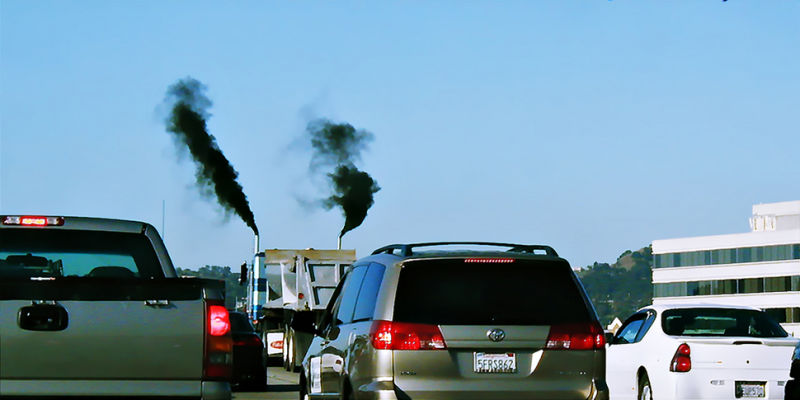
Air pollution kills thousands of Americans every year, even at levels far below the current legal limits set by the Environmental Protection Agency.
That’s the conclusion of the largest study of its kind ever done, performed by the Harvard School of Public Health and published last Thursday in the New England Journal of Medicine. It comes only a month after the Trump Administration signaled a willingness to roll back those current limits.
“Air Pollution and Mortality in the Medicare Population,” has six authors headed up by well-known Epidemiologist Joel Schwartz, of the T.H. Chan Harvard School of Public Health.

Researchers could find no sign of a “safe level” of exposure to either Ozone, aka Smog, or Particulate Matter 2.5, aka Soot at a microscopic level.
For every 1 microgram per cubic meter (µg/m³) reduction in Particulate Matter pollution, 12,000 lives were saved annually. For every 1 ppb of ozone reduction, 1,900 deaths were prevented.
Previous studies have concluded the same thing, but this new one stands out for a variety of reasons:
Size: The study followed over 61 million American seniors in the lower 48 contiguous states, representing 97% of all Americans 65 or older, for 13 consecutive years, 2000 to 2012, totaling 420 million “person-years” of follow-up and analysis.
Accuracy: Researchers developed an entirely new computer model to do the study, combining on-the ground air-monitoring data and satellite-based measurements to estimate pollution levels across the continental U.S at a resolution of 1-square-kilometer. Most current air computer models, including the ones used to predict DFW smog levels, run at a level of 5 to 10 kilometers square.
Telescoping in at the local level gave the authors the ability to estimate the levels of smog and ozone level exposures to seniors by Zip Code.
Scope: Unlike previous studies, this one’s ability to get down to the community level meant it could look at rural areas never included before. It’s size also “allowed for unprecedented accuracy in the estimation of risks among racial minorities and disadvantaged sub-groups.”
Men, Blacks, Asians, Latinos, and lower-income seniors all faced increased risk of death from exposure to Particulate Matter. Black seniors were three times more likely to die from PM exposure as the senior population as a whole.
Since the Clean Air Act (still) requires the EPA to set air quality standards that “protect sensitive populations,” a number of Environmental Justice issues, and lawsuits, might arise from the study’s findings.
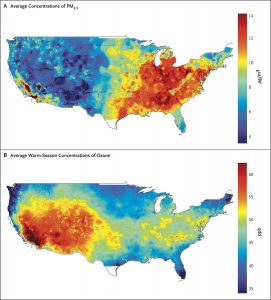
Extremely Low Levels of Pollution: With Particulate Matter, the study saw a significant increase in the risk of death rise when seniors were exposed to as little as 5 micrograms per cubic meter (µg/m³), the lowest level measured. The current EPA standard for PM exposure is 12 µg/m³. Ozone levels as low as 30 parts per billion, also the lowest measured, increased the risk of death as well. The current standard is 75 ppb, with a planned phase-in to a 70 ppb level approved by the Obama Administration in 2015 now seriously in doubt.
Seniors’ chances of dying decreased every time PM levels were decreased. However, in a strange indicator of just how harmful lower levels of pollution are, their chances of dying decreased more when those PM levels decreased BELOW the current standard of 12 µg/m³. That is, more lives were saved by cutting PM levels back from 12 to 5 µg/m³ than from say, 17 to 12 µg/m³.
PM and ozone both are primarily caused by combustion – whether it’s from engines in cars and trucks, furnaces in power plants and cement kilns, or diesels running gas and oil pipeline compressors or locomotives.
DFW’s current annual average for ozone is 80 ppb with a new 2017 average due after ozone season is completed in October. Our annual
DFW annual PM levels have averaged anywhere from 8 to almost 12 but we’ve gone over the 12 µg/m³ annual standard a number of days every year. In this 2013 study both Fort Worth and Dallas had almost 80 days above the national annual standard.
Despite its impressive size and scope, the study gives only a partial view of the public heath damage done by air pollution.
It only looks at the impacts on those 65 and older. Left out of its analysis are children, whose lungs are more sensitive because they’re not fully developed, and everyone under 65 with COPD, asthma, or other existing respiratory/cardiovascular conditions that would be exacerbated by bad air.
It also leaves out any impact short of death. This is especially important when it comes to PM pollution, which has now been linked to a number of neurological diseases like Parkinson’s, Dementia, and Autism, as well as to infertility and immune system damage. Ozone exposure can cause strokes, non-fatal heart attacks, and asthma emergencies. None of these potentially disabling results that fall short of dying are included in the damage assessment of this new study.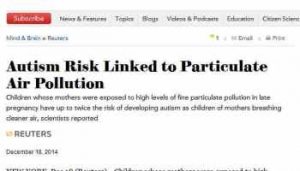
At a time when the current EPA is seeking every opportunity to roll back, cut back and turn back, this study is a large, unprecedented reminder that the current standards themselves are not protecting public health. Not even close.
Citizens must begin to fight for their lungs by reducing the exposure levels across the board, no matter the regulatory status of the pollutant, or compliance of the source. There is no safe level of industrial crap to breathe.
That means more than anti-idling zones at schools.
California has a recommended buffer zone of 500 to 1000 feet from major freeway corridors for new schools. Dallas -Forth Worth municipalities should expand this idea to daycare centers, parks and senior centers, and solidify it into policy instead of just recommendation.
Mitigation measures along those corridor using recycled water walls to “rain” down the particulate matter from traffic, or retrofitting sophisticated new air filters in homes and apartments for citizens are also needed to help those who cannot simply move away from the problem yet.
Portable monitors should be bought and distributed to help identify local PM hotspots and catch bad actors or work to lower levels of pollution. The DFW Air Research Consortium’s regional grid of sensors could be used to track PM plumes in real time.
It’s clear we’ll get no help from Austin or Washington with these efforts. Indeed, progress will be made despite them. If we have a TCEQ and EPA only interested in pollution promotion, we must fight for more pollution protection ourselves in the places where we live.
Is that a Disco Ball, or is Your Photoluminescence Experiment Just Glad to See Me?
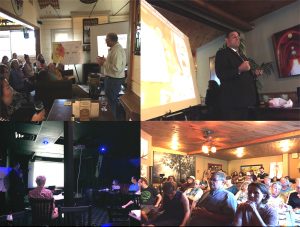
Downwinders’s “Evenings of Science and Socializing”
Concludes with SRO Crowd in Denton
We’re pretty sure it was the first time Cambridge-trained UTD Physicist Dr. David Lary had presented in a bar.
The occasion was opening night of Downwinders’ “Evenings of Science and Socializing” at Bryan Street Tavern, in a dark back room that came complete with fog machine, disco ball, and a too-close juke box.
But Dr. Lary is nothing if not persistent. He’s applied for one grant after another in trying to fund his dream of a regional grid of hundreds or thousands of air monitoring sensors. He was told not to even bother applying for a prestigious National Science Foundation grant. That would be the same grant he and his consortium of colleges, cities, and citizens groups are now in the running for. That kind of persistence is why he’s an honorary Downwinder.
And so, like the trooper he is, Dr. Lary pushed through all the distractions and pitched his plan to an audience of about a dozen and half, including wayward bar patrons who stumbled onto the exhibit and stuffed $5 dollar bills into the donation jar.
Four nights later it was Dr. David Sterling of the UNT Health Science Center explaining how his school’s partnering with the Fort Worth League of Neighborhoods gave birth to the design of the portal used by the public to access the monitoring information. His talk drew about two dozen citizens to the Ginger Man pub, including many that had been directly involved in the focus groups he had sponsored over the past five years.
And two nights after that, Dr. Lary and UNTHSC Environmental Health doctoral candidate Leslie Allsop showed up at the Greenhouse in Denton with a Standing Room Only crowd of at least 40-50 folks, plus a few latecomers who were turned away.
Some of the audience questions were the same at every meeting. How much do the sensors cost? How do we get one or more of them? Some were particular to the location or audience being addressed, like why is Denton always the “worst-performing monitor” in North Texas? Answer: location, location, location.
All of these meetings were the first time the general public had been invited to look at the technology and plans of the DFW Air Research Consortium, (DFW ARC) the less-than-year old group that’s gaining momentum in its quest to use high tech solutions to decades-old problems. Downwinders has been instrumental in establishing and administering the group. It includes the cities of Dallas, Fort Worth, Plano, the School Districts of those cities plus Richardson and the Dallas County Community College system, TCU, UTA, UNT and UTD, plus Livable Arlington and Mansfield Gas Well Awareness.
 News of the National Science Foundation grant the Consortium applied for should be coming any day now. Considering the competition, it would be quite incredible if the Consortium won. It would generate much needed publicity and increase our chances for getting other grants. But regardless, the work that went into the NSF grant has produced a template for the Consortium to apply to other foundations and individuals to grow the same regional grid of sensors. The work won’t stop if the NSF money doesn’t come through.
News of the National Science Foundation grant the Consortium applied for should be coming any day now. Considering the competition, it would be quite incredible if the Consortium won. It would generate much needed publicity and increase our chances for getting other grants. But regardless, the work that went into the NSF grant has produced a template for the Consortium to apply to other foundations and individuals to grow the same regional grid of sensors. The work won’t stop if the NSF money doesn’t come through.
Proof of that are two on-going projects of the Consortium and its members that are already up and running.
The “10-Schools” project at UTD is one where a select number of schools across the Metromess will be paired with Particulate Matter and Ozone monitors in the first attempt to sketch out the frame of a regional grid system. Selection of the schools is being weighed right now. At every meeting there was a suggestion from citizens for this or that school that should be included based on its proximity to a large pollution source, or high absentee rates. It will be tough to narrow all those suggestions down to ten.

In the Fall, the project will be distributing the monitors, being assembled now at Dr. Lary’s lab at UTD. They’ll come with a video camera, a micro meteorology unit, and the pollution sensors themselves. Students will be able to use the monitors as a tool in classes. Neighborhoods will be able to use the information to better protect themselves. It will be the beginning of building a regional grid that identifies and tracks air pollution much better than the state or EPA does now.
Then there’s Downwinder’s own “Wise County Ozone Project,” that will use the two brand new portable ozone monitors we just bought to begin recording smog levels in the one and only county in the “DFW Non-Attainment Area” that doesn’t have any. We have at least one location secured for a stationary monitor, but we need some additional assistance. To pull this off, we need:
– Carpenters that can help us assemble a couple of 12-13 foot wooden platforms that will house the monitors.
– Solar expertise and panels to help power the monitors.
– Electrical Engineers that can help us hard wire the monitors to those panels and back-up batteries.
– IT experts who can help us with connectivity issues.
If you or someone you know could be of help in any of these categories, please write us at Info@downwindersatrisk@gmail.com or call us at 469-608-1972.

What these two projects prove is the technology featured in all three of our recent events is here now and being used. We don’t have to wait. We just have to organize ourselves to make effective use of it. Help us do that. With your expertise if you have it. With your time if you can spare any. With a contribution if you can.
There are many things you may feel powerless to change right now but this is a “bricks and mortar” change on the ground that can take place over the next few years and promises to deliver a challenge to both Austin and DC. Become a part of it.
Thanks to Dr. Lary, Dr. Sterling and Ms. Allsop for donating their time and taking on the challenge of bringing science to the public..and pubs. Thanks to our co-sponsors: The Dallas Innovation Alliance, the Fort Worth League of Neighborhoods, and the Denton Drilling Awareness Group. And thanks to everyone who showed up and made these events more useful to citizens. Onward thru the Smog.


